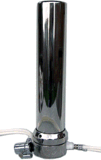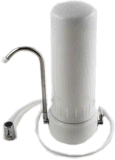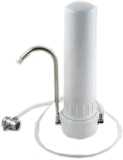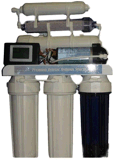The U.S. General Accounting Office reports that
there are serious deficiencies in water treatment plants in
75% of the states. More than 120 million people ( about 50% of
the population) may get unsafe water according to a study
conducted by the Natural Resources Defense Council.
U.S. Health Officials estimate 900,000 people each year
become ill - and possibly 900 die - from waterborne disease.
The General Accounting Office estimates 66% of Safe Drinking
Water Act violations aren't reported.
The contamination of water is directly related to the
degree of contamination of our environment. Rainwater flushes
airborne pollution from the skies, and then washes over the
land before running into the, rivers, aquifers, and lakes that
supply our drinking water. Any and all chemicals generated by
human activity can and will find their way into water
supplies.
The
chemical element chlorine is a corrosive, poisonous, greenish
yellow gas that has a suffocating odor and is 2 1/2 times
heavier than air. Chlorine belongs to the group of elements
called halogens. The halogens combine with metals to form
compounds called halides.  Chlorine is manufactured commercially by running an electric
current through salt water. This process produces free
chlorine, hydrogen, and sodium hydroxide. Chlorine is changed
to its liquid form by compressing the gas, the resulting
liquid is then shipped. Liquid chlorine is mixed into drinking
water and swimming pools to destroy bacteria.
Chlorine is manufactured commercially by running an electric
current through salt water. This process produces free
chlorine, hydrogen, and sodium hydroxide. Chlorine is changed
to its liquid form by compressing the gas, the resulting
liquid is then shipped. Liquid chlorine is mixed into drinking
water and swimming pools to destroy bacteria.
Until recently, concerns about drinking water focused on
eliminating pathogens. The chlorine used to reduce the risk of
infectious disease may account for a substantial portion of
the cancer risk associated with drinking water. Chlorination
of drinking water was a major factor in the reduction in the
mortality rates associated with waterborne pathogen. The use
of chlorine was believed to be safe. This view is evident in
an article, which appeared on the back page of the New York
Times . The report stated that with the use of chlorine,
"Any municipal water supply can be made as pure as
mountain spring water.
Chlorination destroys all animal and microbial life,
leaving no trace of itself afterwards.". This statement
reflected opinion accepted until recent years when halogenated
organic compounds, such as chloroform, were identified in
chlorinated drinking water supplies. Recent surveys show that
these compounds are common in water supplies throughout the
United States.
These concerns about cancer risks associated with chemical
contamination from chlorination by-products have resulted in
numerous epidemiological studies. These studies generally
support the notion that by-products of chlorination are
associated with increased cancer risks.
Chlorine is used to combat microbial
contamination, but it can react with organic matter in the
water and form dangerous, carcinogenic trihalomethanes.
According to Dr. Joseph M. Price, MD, in Moseby's Medical
Dictionary, "Chlorine is the greatest crippler and killer
of modern times. It is an insidious poison.".
In a 1992 study that made front page headlines, and was
reported on in the July issue of the American Journal of
Public Health researchers at the Medical College of Wisconsin
in Milwaukee found that people who regularly drink tap water
containing high levels of chlorine by-products have a greater
risk of developing bladder and rectal cancers than people who
drink unchlorinated water.
The study estimates that about 9
percent of all bladder cancer and 18 percent of all rectal
cancer cases are associated with long-term consumption of
these by-products. This amounts to over 20,000 new
cases each year.
Morris, with epidemiologist Thomas C. Chalmers and his
colleagues at Harvard, used a new technique called
meta-analysis to combine the results from the 10 best studies,
yielding the new findings. They report that people drinking
chlorinated water over long periods have a 21% increase in the
risk of contracting bladder cancer and a 38% increase in the
risk of rectal cancer.
"I am quite convinced, based on this study, that there
is an association between cancer and chlorinated water.",
says Robert D. Morris of the Medical College of Wisconsin in
Milwaukee, who directed the new study.
About 90% of the population is
drinking water which may contain hundreds of these
Disinfection By-products (DBPs), also known as Trihalomethanes.
The Environmental Protection Agency lowered the Maximum
Contaminant Level for Disinfection By-products but it will be
years before the new standard goes into effect.
In his book, Coronaries/Cholesterol/Chlorine, Joseph M.
Price, MD presents startling evidence that trihalomethanes,
are the "prime causative agents of arteriosclerosis and
its inevitable result, the heart attack or stroke." These
trihalomethanes are created when the chlorine that is added to
the municipal water supply reacts with organic matter such as
leaves, twigs, or chemicals from agricultural runoff. | top
of page |
|









